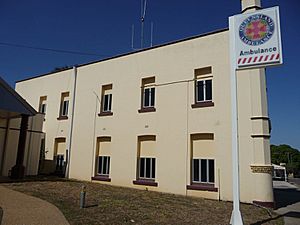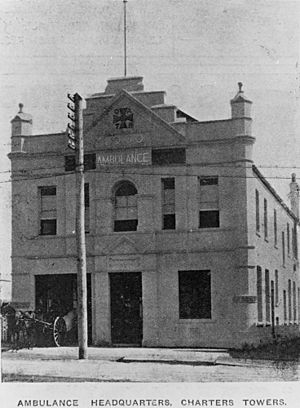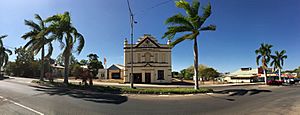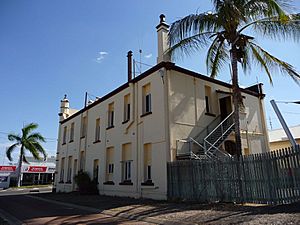Ambulance Building, Charters Towers facts for kids
Quick facts for kids Ambulance Building |
|
|---|---|

Ambulance Building, Charters Towers, 2015
|
|
| Location | 157 Gill Street, Charters Towers City, Charters Towers, Charters Towers Region, Queensland, Australia |
| Design period | 1900–1914 (Early 20th century) |
| Built | 1903 |
| Architect | Walter Hunt |
| Architectural style(s) | Classicism |
| Official name: Ambulance Building (former) | |
| Type | state heritage |
| Designated | 4 December 2015 |
| Reference no. | 650009 |
| Type | Health and care services: Ambulance station |
| Theme | Providing health and welfare services: Providing health services |
| Builders | Arthur Reid & James Walker |
| Lua error in Module:Location_map at line 420: attempt to index field 'wikibase' (a nil value). | |
The Ambulance Building in Charters Towers is a very old building. It used to be an ambulance station and is now a museum. It was built in 1903 and designed by an architect named Walter Hunt. This building is special because it was one of the first places in Queensland to have a dedicated ambulance service. It shows how important it was to help people who were sick or hurt, especially in a busy gold mining town. Today, you can visit it to learn about the history of ambulances in Queensland.
Contents
A Look Back: Charters Towers History
Gold Rush Days in Charters Towers
Charters Towers became a town after gold was found there in 1871. Soon, many people moved to the area, and the town grew quickly. By 1877, it was officially a municipality, which is like a small city.
The town really boomed in the 1880s. It became Queensland's most successful goldfield. A railway line built in 1882 made it easier to get supplies. More money came from investors, and in 1889, a very rich gold reef was found.
Charters Towers produced more gold than any other place in Queensland for many years. It was even the third largest gold-producing area in Australia. Around 1900, Charters Towers was Queensland's second-biggest city. It had about 26,500 people and was known as "the World."
Why an Ambulance Service Was Needed
Working in the gold mines was very dangerous. Many miners got hurt or sick. Accidents were common, and poor hygiene led to illnesses like typhoid. Miners also suffered from lung problems from breathing in dust.
Because of these dangers, people realized an ambulance service was badly needed. Before this, sick or injured people had to get to the hospital on their own. This often made their injuries worse. An ambulance service would provide first aid and transport people safely.
Starting Ambulance Services in Queensland
In 1900, the City Ambulance Transport Brigade (CATB) in Brisbane decided to expand. They wanted to set up ambulance services in other big towns. A man named R Nye Stevens visited Charters Towers to talk about it.
A public meeting was held in October 1900. People learned that an ambulance center would need paid officers and many volunteers. It would also need special stretchers and equipment. The community would help pay for it, with some money from the government.
As a result, the Charters Towers Ambulance Brigade started in December 1900. It was the first regional ambulance center in Queensland. It first operated from the fire station, then moved to a house.
In 1902, the CATB changed its name to the Queensland Ambulance Transport Brigade (QATB). This showed that it was growing across the state. Many other towns, especially gold mining towns like Charters Towers, Ravenswood, and Gympie, were among the first to get these services.
Building the Ambulance Station
A Permanent Home for the Ambulance
Soon, the Charters Towers Ambulance Brigade needed its own permanent building. In 1901, they started planning to buy land and build a new station. They wanted it to be in a central spot, close to the hospital and the main mines.
Land was bought on Gill Street in 1902. This location was perfect because it was between the city center and the railway station. It was also near the hospital and the important gold reefs.
Designing and Building the Station
A local architect named Walter Hunt was chosen to design the building. He was a well-known architect in Charters Towers from 1899 to 1910. He designed many other important buildings in the town, like the swimming baths and the newspaper building.
Arthur Reid was the main builder, and James Walker did the brickwork. On March 29, 1903, a special ceremony was held to lay the foundation stone. About 1500 people watched! Just a few months later, on June 13, 1903, the building officially opened. It was the second purpose-built ambulance center in Queensland.
The building was described as having a large room on the ground floor for the ambulance cart and stretchers. It even had doors that opened by electricity! Upstairs, there was a boardroom and six bedrooms for the staff. The building was made of strong brick, meant to last a very long time.
A photo from 1905 shows the building looking grand. It had a fancy design with classical features like columns and arches. The QATB logo (a Maltese cross) and the word "AMBULANCE" were part of the decorations. There was a large opening on the ground floor for the horse-drawn ambulance to get in and out quickly.
Changes Over Time
Gold mining in Charters Towers slowed down after 1914. The town's population decreased, but the ambulance service remained important. In fact, its work grew as it started helping people in rural areas outside the town.
In 1915, the Charters Towers Ambulance Brigade got a new motor car for country calls. By 1918, the QATB switched from horse-drawn vehicles to motorized ambulances. This meant they could help more people and travel further.
The Ambulance Building changed over the years to fit these new needs. In 1946, the top floor became a home for the Superintendent. The ground floor was updated for motorized vehicles. This included widening the main door and adding a new awning.
In 1995, a new, modern ambulance building was constructed next to the old one. The original Ambulance Building was then prepared to become a museum. In 2003, some parts of the building's front were rebuilt to look like they did in 1903.
Today, the Ambulance Building is a museum. It displays old ambulance vehicles, uniforms, and records. It helps visitors understand the history of ambulance services in Queensland.
What the Ambulance Building Looks Like
The Ambulance Building is a two-story brick building with a classical design. It has a metal roof and stands out on Gill Street. The front of the building is symmetrical, meaning it looks the same on both sides. It has a central arch and fancy decorations.
Inside the Historic Building
The ground floor used to hold the ambulance vehicles and service rooms. These included a casualty room and a radio room. There was also a workshop and rooms for the ambulance staff. An old metal handrail on the stairs is still there.
The first floor was where the staff lived and where meetings were held. It had a large boardroom and several bedrooms. You can still see the original timber doors and windows. Many rooms have beautiful pressed metal ceilings with decorative patterns. A circular hole in the ceiling shows where a pole used to be, allowing staff to slide down quickly to the ground floor.
Some parts of the building have been updated over time. These include new floor coverings, kitchen and bathroom fittings, and some windows. However, most of the building still looks much like it did when it was first built.
Outdoor Features
There is a driveway along the eastern side of the building. This driveway has been there since the building was first opened. It allowed easy access to the back of the station.
Why This Building is Important
The former Ambulance Building in Charters Towers is a very important historical site.
It shows how ambulance services grew in Queensland, especially in regional towns. It is the oldest known building built specifically for an ambulance service in the state.
This building also shows how important gold mining towns were in starting these services. The dangerous conditions in the mines made ambulances essential.
The building is a great example of an early ambulance station. It has two floors, with ambulance services on the ground floor and living quarters upstairs. Its central location, near the hospital and patients, was key. The building is still mostly in its original condition.
Changes made over the years, like widening doors for motor vehicles, show how ambulance services changed. They moved from horse-drawn carts to modern ambulances.
The Ambulance Building also looks impressive and adds to the beauty of Charters Towers. Its grand design shows how important the ambulance service was to the community.
Finally, this building has a special connection to the Queensland Ambulance Service. This organization has been providing vital ambulance services across Queensland since 1900.




